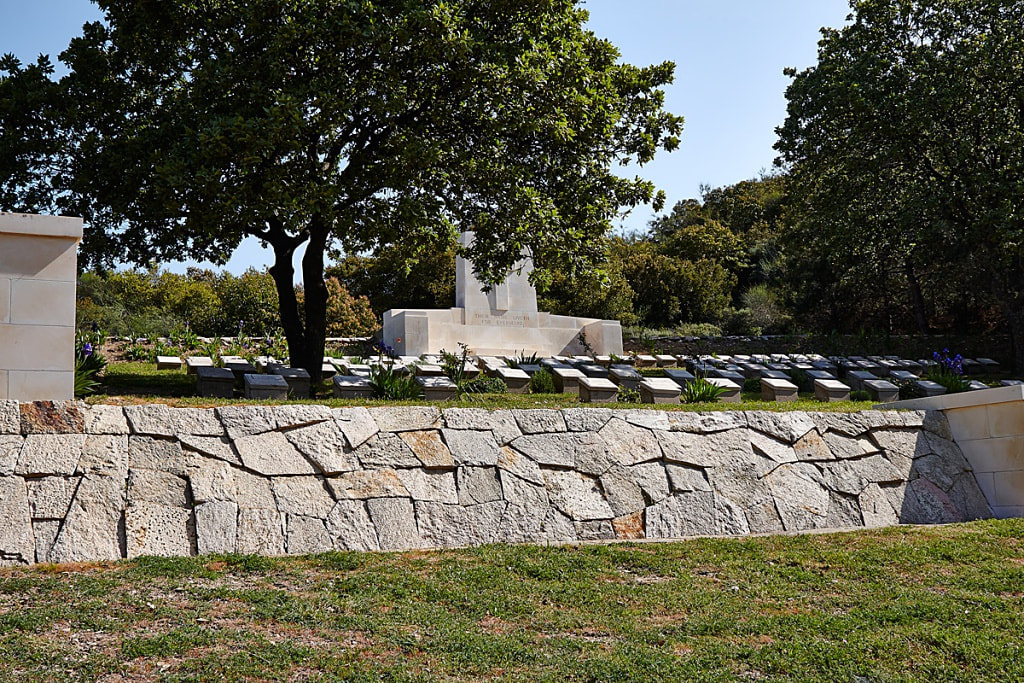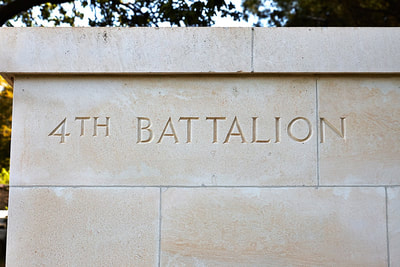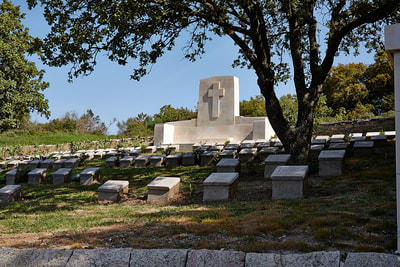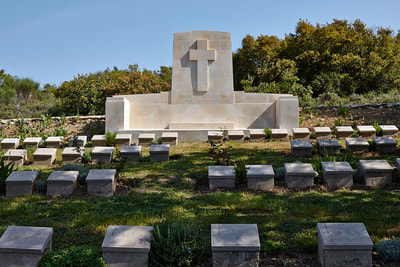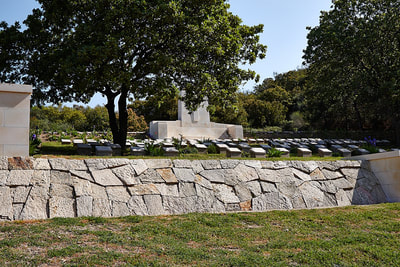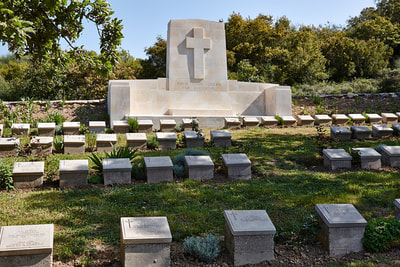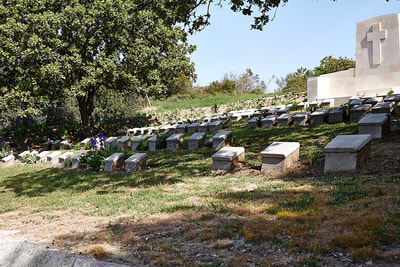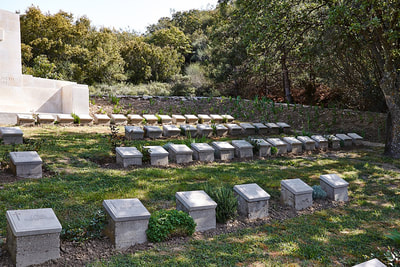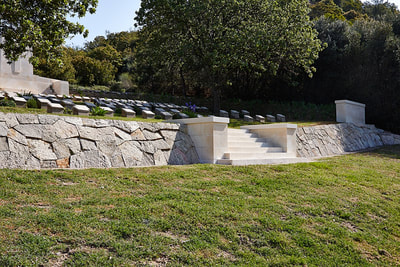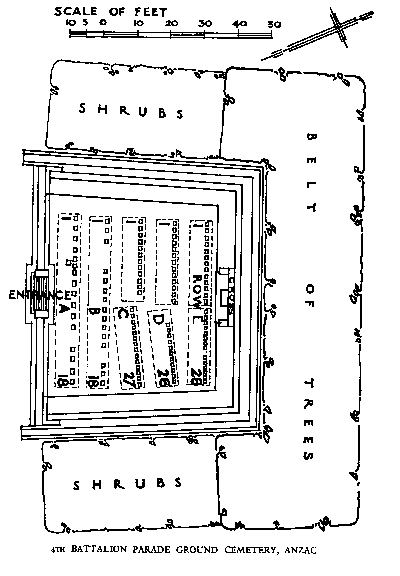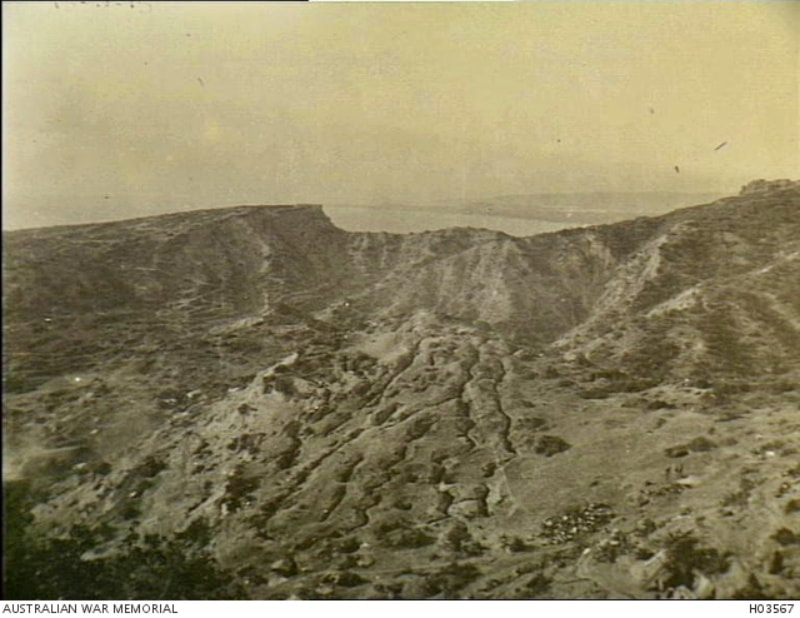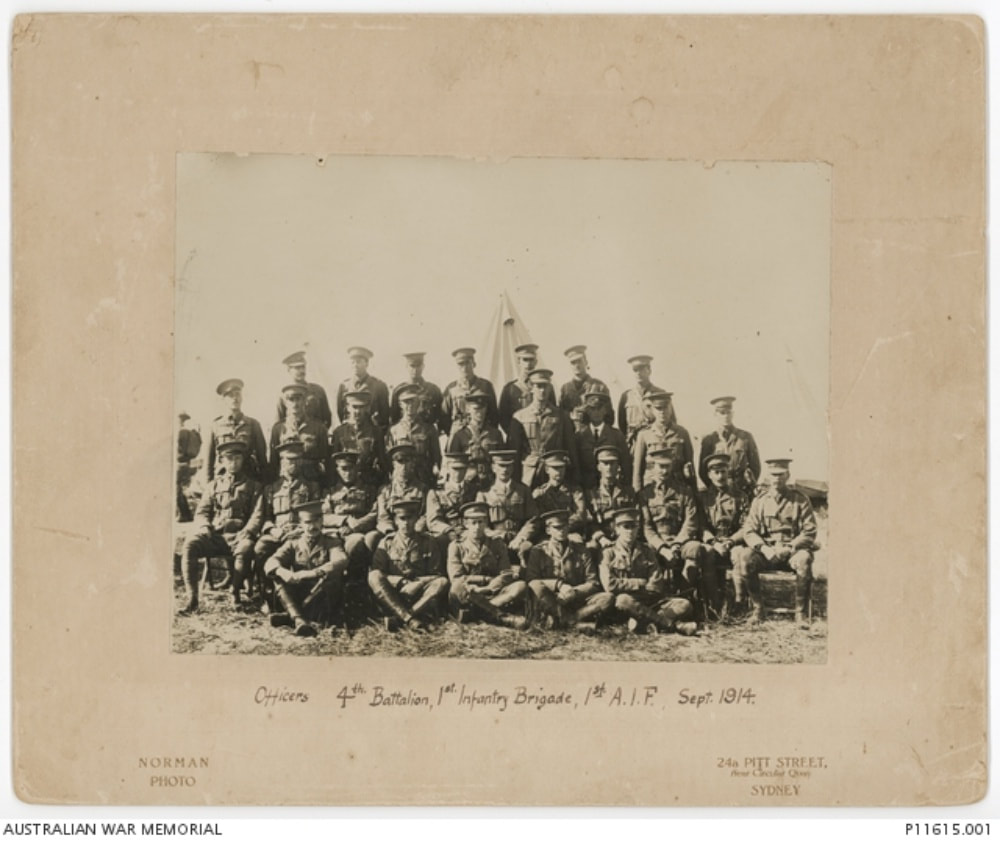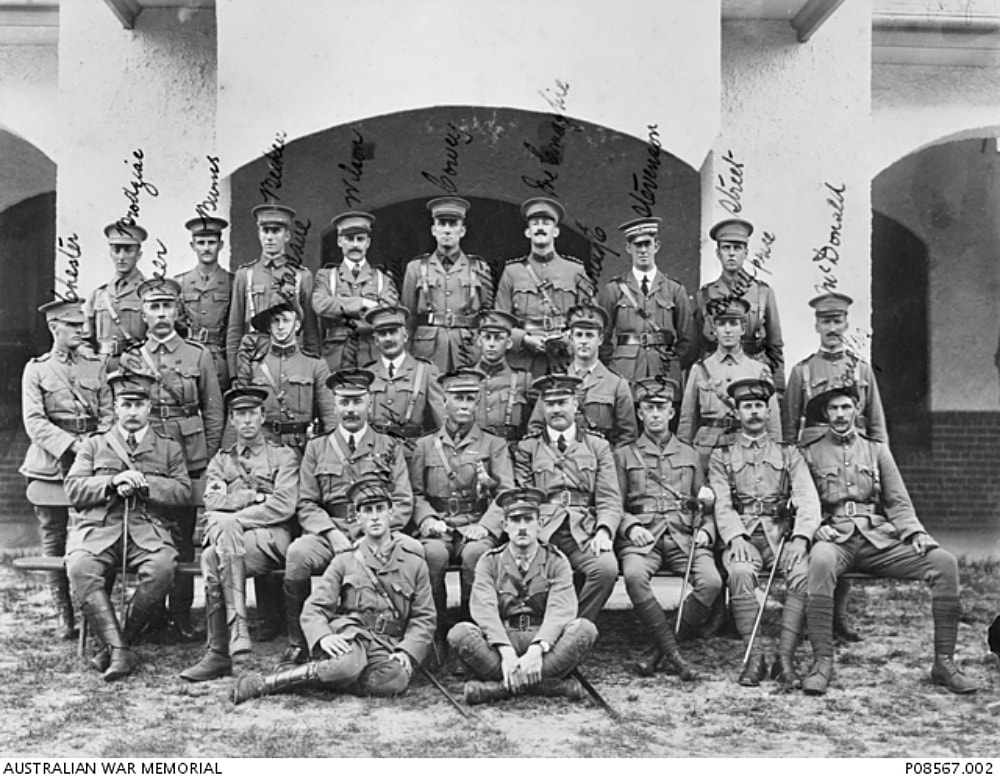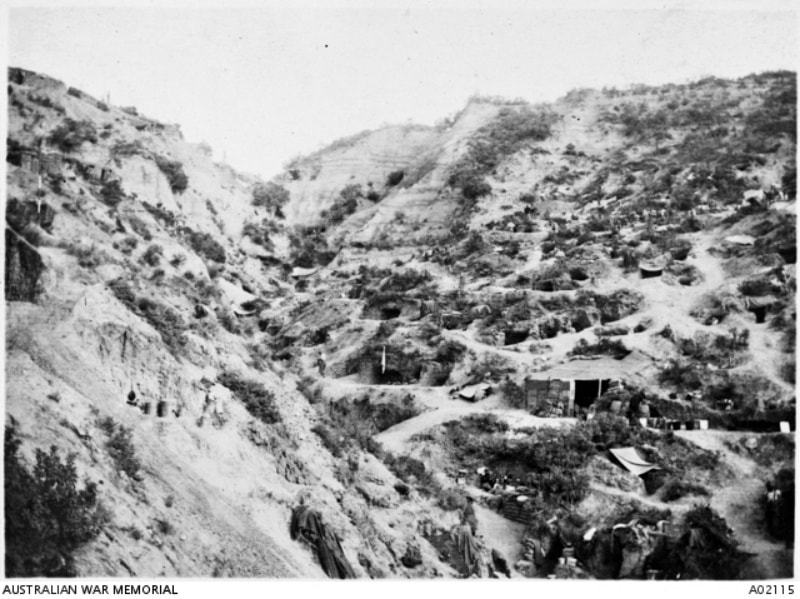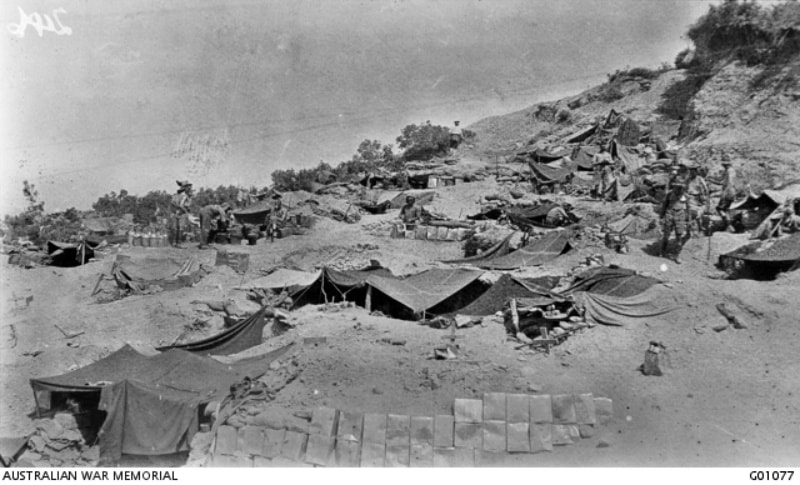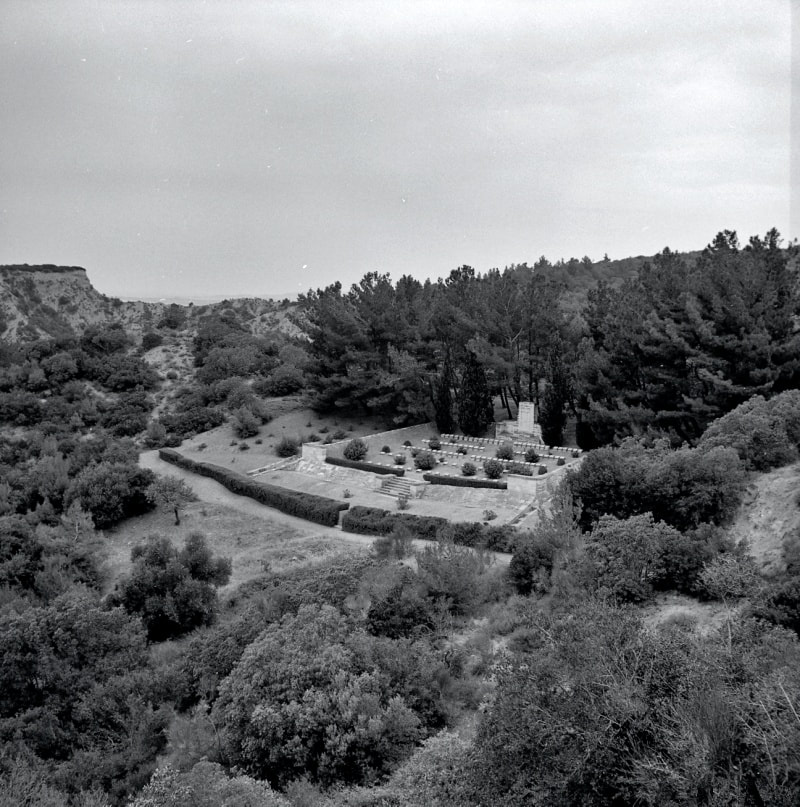4TH BATTALION PARADE GROUND CEMETERY
Gallipoli
Turkey
GPS Coordinates - Latitude: 40.2343, Longitude: 26.28612
Location Information
The Anzac and Suvla cemeteries are first signposted from the left hand junction of the Eceabat- Bigali Road. From this junction the cemetery will be found at 10.9kms. up a steep 200m path on the left of the road. 4th Battalion Parade Ground Cemetery is on the track from the Wire Gully sector of the front line back to Anzac Cove and is not accessible by car.
Visiting Information
The Cemetery is permanently open and may be visited at any time.
Historical Information
The eight month campaign in Gallipoli was fought by Commonwealth and French forces in an attempt to force Turkey out of the war, to relieve the deadlock of the Western Front in France and Belgium, and to open a supply route to Russia through the Dardanelles and the Black Sea.
The Allies landed on the peninsula on 25-26 April 1915; the 29th Division at Cape Helles in the south and the Australian and New Zealand Corps north of Gaba Tepe on the west coast, an area soon known as Anzac.
The 4th Battalion, Australian Imperial Force, was drawn from New South Wales. From the end of April to the beginning of June, 1915, it buried 34 of its dead, and six from other units, in a cemetery on the road from Wire Gully to Anzac Cove (Bridges Road). This burial ground became known as the 4th Battalion Parade Ground Cemetery. It was enlarged after the Armistice by the concentration of 76 graves from the surrounding battlefields and from the following smaller cemeteries:-
The 3RD BATTALION PARADE GROUND CEMETERY, a little way to the South on the opposite side of the valley, which contained the graves of 31 soldiers of the 3rd Battalion, two of whom fell on the 25th of April and the remainder on the 19th-23rd May (in the Defence of Anzac).
The 22ND BATTALION PARADE GROUND CEMETERY, a little way South-East and behind Johnston's Jolly, which contained the graves of 13 soldiers of the 3rd Battalion and three others, who fell on the 16th-20th May.
The cemetery contains 116 First World War burials, 7 of them unidentified.
Identified Casualties:
Australia 106
United Kingdom 6
Pictures in gallery © Geerhard Joos
The Anzac and Suvla cemeteries are first signposted from the left hand junction of the Eceabat- Bigali Road. From this junction the cemetery will be found at 10.9kms. up a steep 200m path on the left of the road. 4th Battalion Parade Ground Cemetery is on the track from the Wire Gully sector of the front line back to Anzac Cove and is not accessible by car.
Visiting Information
The Cemetery is permanently open and may be visited at any time.
Historical Information
The eight month campaign in Gallipoli was fought by Commonwealth and French forces in an attempt to force Turkey out of the war, to relieve the deadlock of the Western Front in France and Belgium, and to open a supply route to Russia through the Dardanelles and the Black Sea.
The Allies landed on the peninsula on 25-26 April 1915; the 29th Division at Cape Helles in the south and the Australian and New Zealand Corps north of Gaba Tepe on the west coast, an area soon known as Anzac.
The 4th Battalion, Australian Imperial Force, was drawn from New South Wales. From the end of April to the beginning of June, 1915, it buried 34 of its dead, and six from other units, in a cemetery on the road from Wire Gully to Anzac Cove (Bridges Road). This burial ground became known as the 4th Battalion Parade Ground Cemetery. It was enlarged after the Armistice by the concentration of 76 graves from the surrounding battlefields and from the following smaller cemeteries:-
The 3RD BATTALION PARADE GROUND CEMETERY, a little way to the South on the opposite side of the valley, which contained the graves of 31 soldiers of the 3rd Battalion, two of whom fell on the 25th of April and the remainder on the 19th-23rd May (in the Defence of Anzac).
The 22ND BATTALION PARADE GROUND CEMETERY, a little way South-East and behind Johnston's Jolly, which contained the graves of 13 soldiers of the 3rd Battalion and three others, who fell on the 16th-20th May.
The cemetery contains 116 First World War burials, 7 of them unidentified.
Identified Casualties:
Australia 106
United Kingdom 6
Pictures in gallery © Geerhard Joos
Roll of Honour
(Click on image to enlarge)
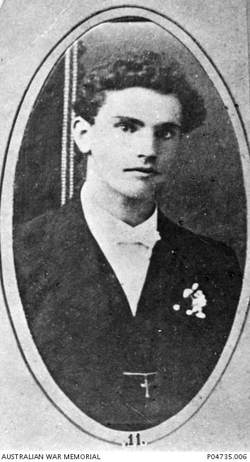
979 Private
Norman Arthur Gribble
4th Bn. Australian Infantry, A. !. F.
19th May 1915.
Row D. 17.
Norman Arthur Gribble of Gulgong, NSW. He enlisted in the AIF on 2 September 1914, serving as 979 Private (Pte) Gribble with the 4th Battalion, embarking from Sydney aboard HMAT Euripides on 20 October 1914. He was killed in action on 19 May 1915 on the Gallipoli Peninsula, Turkey, aged 23 years. His brother, 938 Pte Clement John Gribble, 30th Battalion, was killed in action on 22 March 1917. This image was taken from a collage of the descendants of Benjamin Rixon held at P04735.002.
Norman Arthur Gribble
4th Bn. Australian Infantry, A. !. F.
19th May 1915.
Row D. 17.
Norman Arthur Gribble of Gulgong, NSW. He enlisted in the AIF on 2 September 1914, serving as 979 Private (Pte) Gribble with the 4th Battalion, embarking from Sydney aboard HMAT Euripides on 20 October 1914. He was killed in action on 19 May 1915 on the Gallipoli Peninsula, Turkey, aged 23 years. His brother, 938 Pte Clement John Gribble, 30th Battalion, was killed in action on 22 March 1917. This image was taken from a collage of the descendants of Benjamin Rixon held at P04735.002.
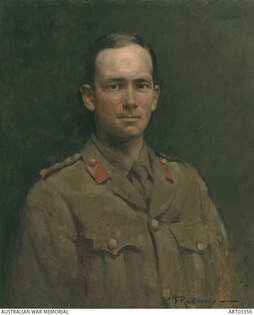
Colonel
Henry Norman MacLaurin, Mentioned in Despatches
1st H. Q. Australian Brigade
27th April 1915, aged 37.
Row A. 10.
Son of the late Sir Henry Normand MacLaurin (Chancellor of Sydney University) and Lady Eliza Ann MacLaurin (nee Nathan).
His headstone bears the inscription; "Neither Counted I My Life As Dear Unto Myself."
Colonel (posthumously Brigadier General) Henry Normand MacLaurin, formed and commanded the 1st Infantry Brigade, Australian Imperial Forces. On the afternoon of 27 April 1915, only two days after the landing at Gallipoli, MacLaurin, a young barrister from Sydney was killed instantly by a Turkish sniper while directing operations on a feature which bore his name, MacLaurin's Hill. Some weeks after his death an order was issued promoting a number of Australian Imperial Force colonels - including MacLaurin - to the temporary rank of Brigadier-General.
Henry Norman MacLaurin, Mentioned in Despatches
1st H. Q. Australian Brigade
27th April 1915, aged 37.
Row A. 10.
Son of the late Sir Henry Normand MacLaurin (Chancellor of Sydney University) and Lady Eliza Ann MacLaurin (nee Nathan).
His headstone bears the inscription; "Neither Counted I My Life As Dear Unto Myself."
Colonel (posthumously Brigadier General) Henry Normand MacLaurin, formed and commanded the 1st Infantry Brigade, Australian Imperial Forces. On the afternoon of 27 April 1915, only two days after the landing at Gallipoli, MacLaurin, a young barrister from Sydney was killed instantly by a Turkish sniper while directing operations on a feature which bore his name, MacLaurin's Hill. Some weeks after his death an order was issued promoting a number of Australian Imperial Force colonels - including MacLaurin - to the temporary rank of Brigadier-General.
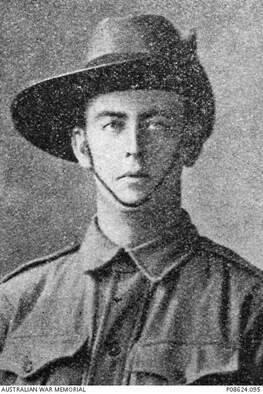
1486 Sergeant
Athol William McKinnon
3rd Bn. Australian Infantry, A. I. F.
Died between 6th June 1915 ,and 13th June 1915.
Row A. 13.
Son of Angus William and Annie Geddes McKinnon. Native of Port Macquarie, New South Wales.
1486 Sergeant Athol William Mckinnon, 3rd Battalion of Port Macquarie, NSW. A school teacher prior to enlisting, he embarked on 5 April 1915. He was killed in action at the Dardanelles, Gallipoli, Turkey between 6 June 1915 and 13th June 2015, aged 32.
Athol William McKinnon
3rd Bn. Australian Infantry, A. I. F.
Died between 6th June 1915 ,and 13th June 1915.
Row A. 13.
Son of Angus William and Annie Geddes McKinnon. Native of Port Macquarie, New South Wales.
1486 Sergeant Athol William Mckinnon, 3rd Battalion of Port Macquarie, NSW. A school teacher prior to enlisting, he embarked on 5 April 1915. He was killed in action at the Dardanelles, Gallipoli, Turkey between 6 June 1915 and 13th June 2015, aged 32.
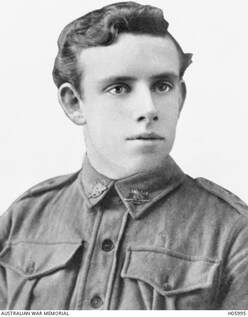
91 Bugler
Milton Frank Thornton
3rd Bn. Australian Infantry, A. I. F.
19th May 1915, aged 20.
Row E. 8.
Son of Thomas and Mahala Thornton, of Argyle St., Camden, New South Wales.
His headstone bears the inscription; "Greater Love Hath No Man Than This."
91 Bugler Milton Frank Thornton, 3rd Battalion from Camden, NSW. A 19 year old tailor prior to enlisting on 1 September 1914, he embarked for overseas with A Company from Sydney on 14 October 1914 aboard HMAT Euripides. While serving at Gallipoli, he was killed in action on 19 May 1915, aged 20.
Milton Frank Thornton
3rd Bn. Australian Infantry, A. I. F.
19th May 1915, aged 20.
Row E. 8.
Son of Thomas and Mahala Thornton, of Argyle St., Camden, New South Wales.
His headstone bears the inscription; "Greater Love Hath No Man Than This."
91 Bugler Milton Frank Thornton, 3rd Battalion from Camden, NSW. A 19 year old tailor prior to enlisting on 1 September 1914, he embarked for overseas with A Company from Sydney on 14 October 1914 aboard HMAT Euripides. While serving at Gallipoli, he was killed in action on 19 May 1915, aged 20.
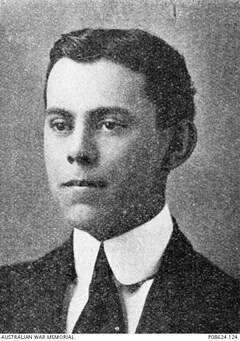
1660 Private
Ronald Alan Mills Watt
3rd Bn. Australian Infantry, A. I. F.
19th May 1915, aged 21.
Row D. 10.
Son of George and Ada Rosalie Watt, of "Rosalie," Cowper St., Harris Park, New South Wales. Native of Parramatta.
1660 Private Ronald Allen Mills Watt, 3rd Battalion of Harris Park, NSW. A school teacher prior to enlisting, he embarked from Sydney aboard the HMAT Seang Choon (A49) on11 February 1915. He was killed in action, on 19 May 1915 at Gallipoli, aged 21.
Ronald Alan Mills Watt
3rd Bn. Australian Infantry, A. I. F.
19th May 1915, aged 21.
Row D. 10.
Son of George and Ada Rosalie Watt, of "Rosalie," Cowper St., Harris Park, New South Wales. Native of Parramatta.
1660 Private Ronald Allen Mills Watt, 3rd Battalion of Harris Park, NSW. A school teacher prior to enlisting, he embarked from Sydney aboard the HMAT Seang Choon (A49) on11 February 1915. He was killed in action, on 19 May 1915 at Gallipoli, aged 21.
Group portrait of officers of the 4th Battalion prior to embarkation. Identified from left to right, back row: Second Lieutenant (2nd Lt) John Dawson Christie from Sydney, NSW (later Lieutenant); 2nd Lt Percival Francis Vere Turner from Edgecliffe, NSW (later Lieutenant); 2nd Lt William Reginald Rogers French from Rose Bay, NSW; 2nd Lt Stanley Lyndall Milligan from Chatswood, NSW (later Lieutenant Colonel and awarded Order of St Michael and St George (CMG), Distinguished Service Order (DSO), and Mentioned in Despatches (MID) five times); 2nd Lt Arthur McKellar Giles from Sydney (later Lieutenant and killed in action at Gallipoli on 8 August 1915); 2nd Lt Desmond Trench from Sydney (later Lieutenant); and 2nd Lt Frederick Fanning from Casino, NSW (later Captain, MID twice and died of wounds in France on 1 November 1916). Third row: 2nd Lt James Bloomfield Osborne from Paddington, NSW (later Captain and MID); 2nd Lt Bertie Vandeleur Stacy from Crossington, NSW (later Lieutenant Colonel and awarded CMG, DSO and Bar, and MID six times); 2nd Lt Edward Acton Lloyd from Rose Bay, NSW (later Major and MID); 2nd Lt James Sinclair Standish Anderson from Glen Innes, NSW (later Major and awarded DSO, Military Cross (MC), and MID three times); Lt Sherard Michael Becher from Strathfield, NSW; 2nd Lt Robert John Allwright Massie from North Sydney (later Lieutenant Colonel and awarded DSO, French Croix de Guerre (C de G) and MID three times); Lt Charles Athleston Chard from Sydney (resigned 3 April 1915); 2nd Lt Richard Thomas Francis Seldon from North Sydney (later Lieutenant and killed in action at Gallipoli on 8 August 1915); and 2nd Lt Arthur Roland Edwards from Sydney (later Major and MID). Second row: Major (Maj) David Andrew Storey from Sydney; Lt Hector Joseph Robert Clayton from Sydney (later Major and MID); Lt J T Simpson, possibly Lt Adam James Simpson from Hunter’s Hill (later Major); Lt Allen Humphrey Scott from Wahroonga, NSW (later Lieutenant Colonel, awarded DSO and MID three times and killed in action in Belgium on 1 October 1917); Maj Charles Melville Macnaghten from Sydney (later awarded CMG and MID); Lieutenant Colonel Astley John Onslow Thompson from Menangle, NSW (later MID and killed in action at Gallipoli on 26 April 1915); Captain (Capt) Iven Gifford Mackay from Raymond Terrace (later Brigadier General and awarded CMG, DSO and Bar, French C de G and MID five times); Capt Stewart Milson from Milson’s Point, NSW (later MID and killed in action at Gallipoli on 7 August 1915); Lt Jasper Kenneth Gordon Magee from Sydney (later Major and awarded MC and MID); Capt James Heane from Dubbo (later Brigadier General and awarded Companion of the Order of the Bath (CB), CMG, DSO, Belgian C de G, and MID five times); and Capt Charles Stanley Coltman from Sydney (later awarded MC and MID and died of disease in Egypt on 6 January 1916). Front row: Lt William Thomas McDonald from Forest Lodge, NSW (later Captain, MID and killed in action in France on 16 August 1916); 2nd Lt Muir Paul Smith from North Sydney (later Lieutenant, MID and killed in action at Gallipoli on 26 April 1915); Capt Arthur Hamilton Tebbutt from Quirindi, NSW (later Lieutenant Colonel and awarded DSO and MID twice); Lt David Richmond Brown from Katoomba, NSW (later Major and awarded MC and MID); and 2nd Lt Clarence Gordon Milne from Darlinghurst, NSW (later Captain).
Group portrait of officers of the 3rd Battalion. Back row, left to right: Second Lieutenant (2nd Lt) Cedric Errol Meyer Brodziak (later awarded DSO; killed in action 31 August 1918); Lieutenant (Lt) Ronald Burns (killed in action 25 April 1915); 2nd Lt William Christian Beeken (killed in action 6 August 1915); Lt John Carandini (Carrandine) Wilson (died of wounds 21 May 1915); Lt Robert Orlando Cowey; Lt (Honorary Captain) David McFie McConaghy (later awarded DSO and CMG; died of wounds 9 April 1918); 2nd Lt Leonard Ken Stevenson and 2nd Lt Lawrence (Laurence) Whistler Street (killed in action 19 May 1915). Second row: Captain (Capt) Charles Edward Leer (killed in action 25 April 1915) ; 2nd Lt Edward MacFarlane MacFarlane (died of wounds at sea 2 August 1918); Lt (Honorary Captain) Colin Douglas Austin (killed 6 August 1915); 2nd Lt Harold Edmund Butler; Lt Eric George Goldring; 2nd Lt Owen Glendower Howell-Price (later awarded DSO and MC; died of wounds 4 November 1916) and Lt George Edward McDonald. Front row, seated on bench: Honorary Lt George Wall; Capt John Willoughby Butler Bean, Medical Officer (MO); Major Alfred Joshua Bennett (later awarded CMG); Lieutenant Colonel Robert Haylock Owen, Commanding Officer (later awarded CMG); Captain Ernest Samuel Brown (killed in action 6 August 1915); Capt Malcolm St John Lamb; Capt Thomas Oscar Smith (killed in action 7 May 1915) and Capt William Bowman Douglas (died of wounds 5 May 1915). At front, seated on ground: 2nd Lt Harold William Goldring and 2nd Lt Kenneth John Hinde (killed in action 5 May 1915). The original contingent of the 3rd Battalion embarked from Sydney on 20 October 1914 on HMAT Euripides (A14).
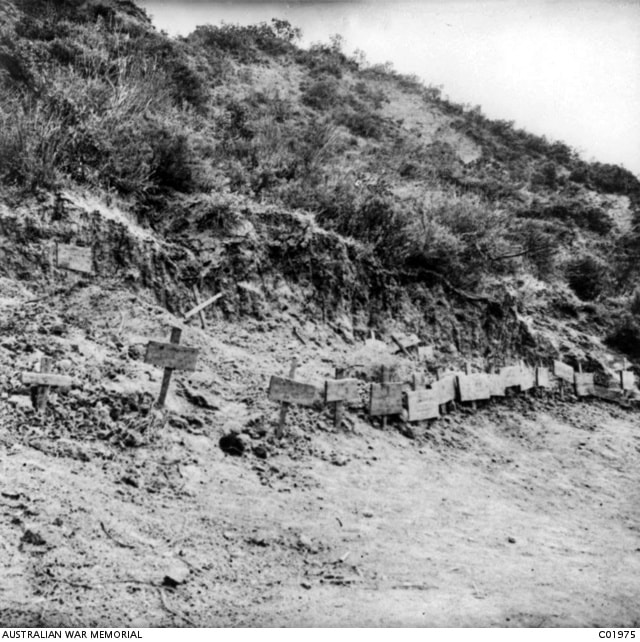
May 1915; The graves of some of the 34 men of the 3rd Battalion who were killed in action on 19 May 1915, including that of Lieutenant (Lt) Laurence Whistler Street. Lt Street was a member of what has become a well known Sydney legal family; his father was the Hon. Justice Philip Whistler Street of the NSW Supreme Court. He is now buried in the 4th Battalion Parade Ground Cemetery.
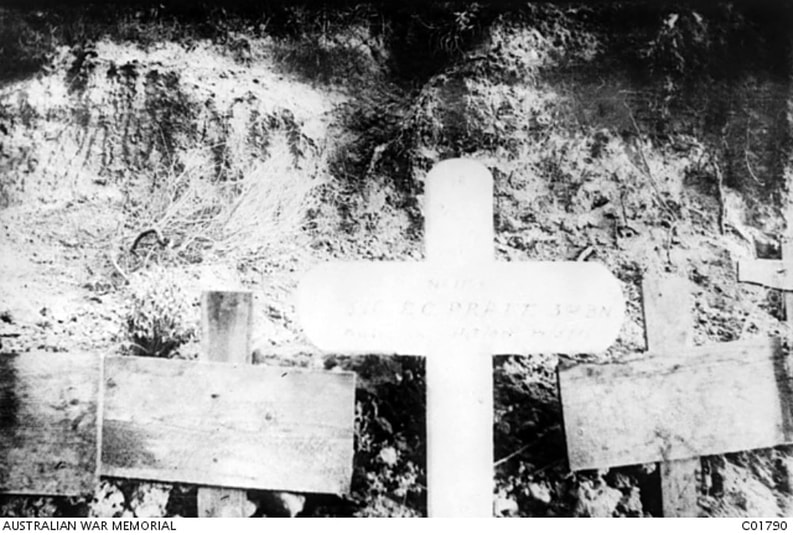
June 1915; The cross marking the grave of 1166 Signaller (Sig) Frederic Charles 'Freddie' Pratt, F Company, 3rd Battalion, of Woodstock, NSW. Sig Pratt enlisted on 17 August 1914 and embarked from Sydney aboard HMAT Euripides on 20 October 1914. He was killed in action on 19 May 1915 at Shrapnel Gully, during a heavy but unsuccessful enemy attack. He is now buried within this cemetery in Row D. 13.

